When you climb Mount Kilimanjaro to its summit at 19,341', you sleep in one of two places: a mountain hut or a tent at designated campsites along the various routes. Most climbers sleep in tented camps, as only the Marangu route offers sleeping huts in dormitory-style accommodations. Everyone hiking one of the other Kilimanjaro routes apart from the Marangu route must camp.
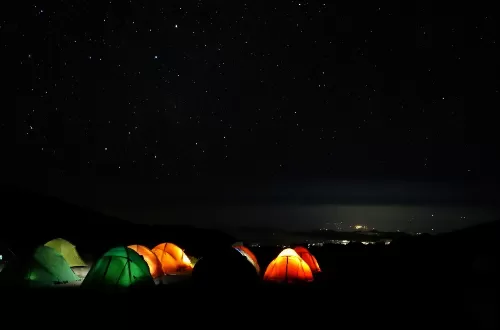
Kilimanjaro's sleeping accommodations
Do you need a satisfied Kilimanjaro tour with a good sleeping accommodation?
Get a free, best price-guaranteed Kilimanjaro tour with a good sleeping accommodation quote and a quick response from us. Call +255 747 989 416 on WhatsApp or email us at exploreafrica024@gmail.com to get a free quote. We are available 24/7 and we are happy to help you.
Hut accommodations on Mount Kilimanjaro
Along the Marangu route, climbers stay in huts instead of camping in tents. There are a total of four huts on the Marangu route: Mandara Hut (2,700 m/8,858 ft), Horombo Hut (3,720 m/12,205 ft), Kibo Hut (4,703 m/15,430 ft), and Gillman's Point (5,681 m/18,638 ft) or Uhuru Peak (5,895 m/19,341 ft) for the summit. The huts on the Marangu route are basic, dormitory-style accommodations with bunk beds and communal dining areas.
Tent accommodations on Mount Kilimanjaro
Climbers are provided with sturdy, waterproof, and lightweight tents to sleep in during the trek. These tents are usually shared between two people, but single tents may also be available for an additional cost or upon request.
Sleeping accommodations on Mount Kilimanjaro in a campsite
Along each route, there are designated campsites where climbers set up their tents for the night. These campsites are strategically located at specific elevations to facilitate proper acclimatization. They usually have basic facilities such as toilet tents or outhouses.
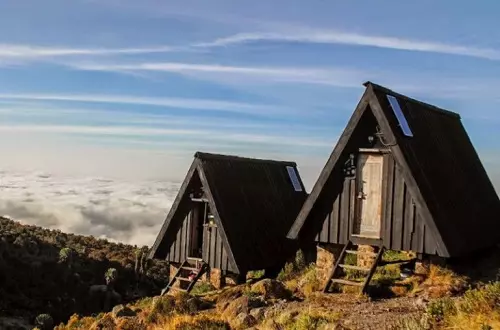
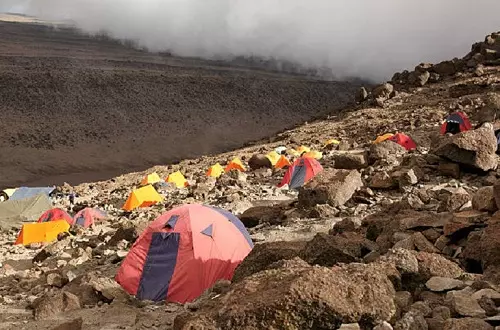
Sleeping bags and sleeping pads on Mount Kilimanjaro
It is important to bring a good-quality sleeping bag suitable for cold temperatures. The best Kilimanjaro's sleeping bag rated for temperatures below freezing (around -10°C/14°F or lower) is recommended. Additionally, a sleeping pad or inflatable mattress is crucial to provide insulation and cushioning between you and the ground.
The best Kilimanjaro routes to hike Kilimanjaro for 2024 and 2025
There are several routes to choose from when climbing Kilimanjaro in different weather and temperatures, each with the best sleeping accommodations and arrangements on trekking tours. Here is the best list of Kilimanjaro hiking routes for you in 2024 and 2025.
5-day Marangu route
6-day Marangu route
6-day Machame route
7-day Machame route
6-day Lemosho route
7-day Lemosho route
8-day Lemosho route
6-day Rongai route
7-day Rongai route
6-day Umbwe route
Is it safe to sleep on Kilimanjaro?
Yes, it is safe to sleep on Kilimanjaro as long as you follow the guidelines and instructions of your tour operator and guide.
What are the different types of sleeping accommodations available on Kilimanjaro?
There are two main types of sleeping accommodations available on Kilimanjaro, depending on the route chosen.
1. Tent sleeping accommodations: Most climbers sleep in tents that are set up at designated campsites along the route. These tents are typically provided by the tour operator and are designed to withstand the mountain's harsh weather conditions.
2. Hut sleeping accommodations: Some routes, such as the Marangu route, have huts that climbers can sleep in instead of tents. These huts are basic but provide shelter from the elements.
Do you need a satisfied Kilimanjaro trip with good sleeping arrangements?
Get a free, best price-guaranteed Kilimanjaro trip with a good sleeping arrangement quote and a quick response from us. Call +255 747 989 416 on WhatsApp or email us at exploreafrica024@gmail.com to get a free quote. We are available 24/7 and we are happy to help you.
How cold does it get at night while sleeping on Kilimanjaro?
The temperature at night while sleeping on Kilimanjaro can vary depending on the altitude and time of year. At lower altitudes, it can be relatively mild, with temperatures ranging from 10–15 °C (50–59 °F). However, as you climb higher, the temperature can drop significantly, with temperatures at the summit often reaching below freezing. It is important to have proper gear and clothing to stay warm in these conditions. It is recommended to consult with a licensed tour operator for guidance on what to pack and how to prepare for sleeping on Kilimanjaro.
Can I bring my own sleeping bag, or do I have to rent one?
Yes, you can bring your own sleeping bag when climbing Kilimanjaro. However, it is important to ensure that your sleeping bag is suitable for the conditions on the mountain. The temperatures on Kilimanjaro can drop below freezing, so it is recommended to bring a sleeping bag that is rated for at least -10°C. If you do not have a suitable sleeping bag, you can rent one from the tour operator or rental shops in Moshi or Arusha. It is important to check with your tour operator beforehand to confirm whether they provide sleeping bags or not.
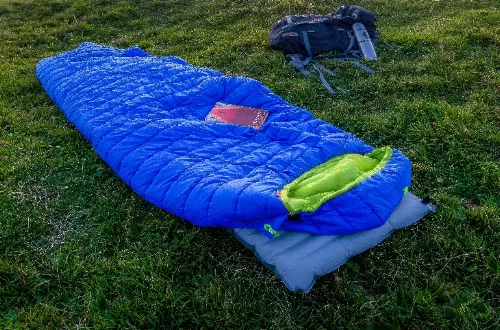
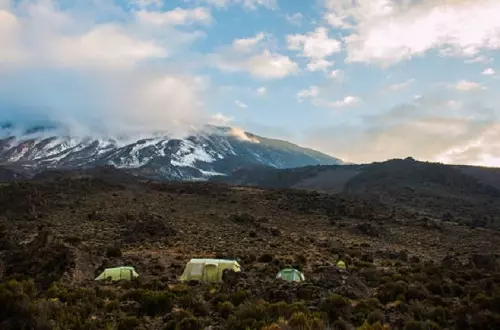
Are there any precautions I should take while sleeping on Kilimanjaro?
Your sleeping mat should be thick and insulated to keep you warm and comfortable. A thermal sleeping mat is important for keeping you warm and comfortable at night. Remember that you fortunately don't have to carry your own sleeping gear, as the porters in your mountain crew do this for you.
Can I sleep in a tent, or do I have to sleep in a hut on Kilimanjaro?
Yes, you can sleep in a tent while climbing Kilimanjaro. In fact, most climbers choose to sleep in tents, as it allows for more flexibility in terms of camping locations and provides a more immersive experience with the mountain. However, some routes on Kilimanjaro require the use of huts, and some climbers prefer the comfort and convenience of sleeping indoors. It ultimately depends on your personal preference and the route you choose to take.
Kilimanjaro's best sleeping accommodations on climbing tours